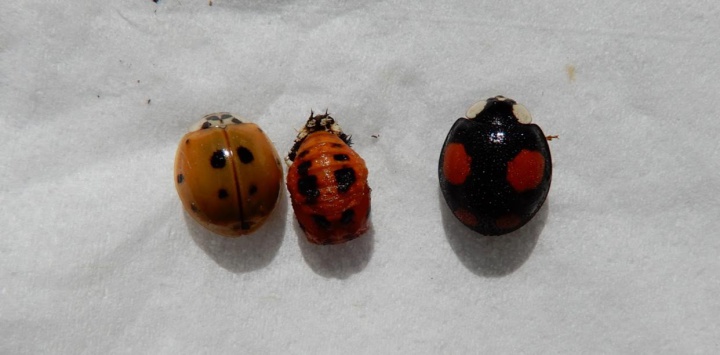Harlequin Ladybirds threat to local horticulture
Media Release
Release date: 03/04/2018
Harlequin Ladybirds threat to local horticulture

Photo credit: John McLean
Infestations of Harlequin Ladybirds in the
Gisborne district could pose a threat to the horiticulture
and viticulture industries.
Originally from Asia, the invasive species was first reported to the Ministry of Primary Industries in Auckland in 2016 and has since been found in the Waikato, Bay of Plenty and Taranaki regions.
Locally it has been discovered in Te Karaka and Matokitoki Valley.
Harlequin Ladybirds are a potential threat to the horticulture industry where they feed on pip fruit, causing blemishes on the fruit. They are known to cluster within bunches of grapes before harvest resulting in tainted juice.
Harlequin Ladybirds also pose a nuisance to humans where they swarm in buildings and houses. They can bite and cause allergic rhinoconjunctivitis.
They eat other insect species and compete for food resources, posing a risk to the biodiversity of our ecosystem. They will eat native ladybirds and also swarm in behives over winter, requiring manual removal.
Due to the highly variable nature of Harlequin Ladybirds they can be hard to distinguish them from other ladybird species. The M shaped markings between the head and abdomen and two small bumps on the rear of the back are their identifying features, they are also slightly larger than common ladybirds.
The larvae and pupae have a spikier skin than common spotted ladybirds.
If you find Harlequin Ladybirds, please collect the speciman, photograph it and contact MPI’s free 24-hour pest and disease hotline on 0800809966.
MPI are tracking their spread and can provide information to growers about the insect and its management.
ENDS


 Gordon Campbell: On The Parental Panic Over Young Kids Online
Gordon Campbell: On The Parental Panic Over Young Kids Online NZCTU: Unions Barred From Budget 2025 Lock-Up
NZCTU: Unions Barred From Budget 2025 Lock-Up Local Water Done Well: Local Water Done Not So Well | Public Understanding And Confidence In Framework Severely Lacking – New Data
Local Water Done Well: Local Water Done Not So Well | Public Understanding And Confidence In Framework Severely Lacking – New Data New Zealand Police: Statement Regarding Jevon McSkimming
New Zealand Police: Statement Regarding Jevon McSkimming Climate Liberation Aotearoa: Climate Activist Draw Attention To Outdated Regulations Of Heli Tourism In Aoraki National Park
Climate Liberation Aotearoa: Climate Activist Draw Attention To Outdated Regulations Of Heli Tourism In Aoraki National Park The New Zealand Remembrance Army: Victoria Cross And Hardham Cup Come Together For First Time In Over 100-years
The New Zealand Remembrance Army: Victoria Cross And Hardham Cup Come Together For First Time In Over 100-years Queer Endurance in Defiance: Wellington Queer Communities Protest Against NZ First’s Anti-Trans Bill
Queer Endurance in Defiance: Wellington Queer Communities Protest Against NZ First’s Anti-Trans Bill


